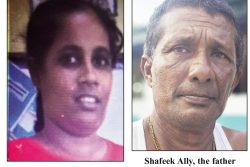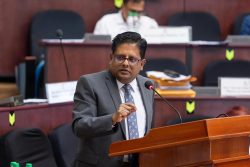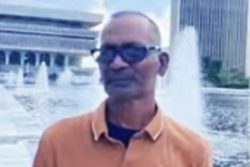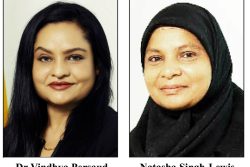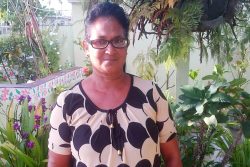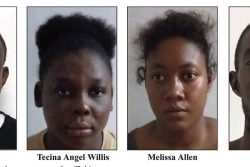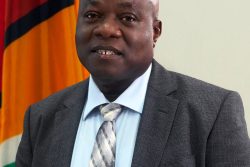Dear Editor,
Sir Ronald Sanders in his contribution to the Kaieteur News on August 12, 2012, shared with readers what he feels needs to be done if the Caribbean Community (Caricom) must sustain and improve its already stunning performance in track and field as was demonstrated recently at Olympic Games. Essentially he argues that it would be in the region’s interest if we pool our meagre resources into the creation of a modern facility, staffed by competent coaches designed to offer the region’s athletes our maximum support as they prepare themselves to do battle on our behalf against the rest of the world. His suggestion is sensible, laudable and attractive. But it is his observation that “all countries that want their sports people to do well because of the pride it brings to their people and the joy of seeing them win, have to invest in the facilities they need to become world champions,” that I want to focus on as it relates to what is going on in Guyana.
The presence of a modern facility for track and field is not enough. If such a facility is to be meaningful, then where it is located is even more important. A seemingly obvious observation, so obvious that Sir Ronald did not feel it needed to be said. However, we who have been living in Guyana over the last sixteen years have come to recognize that our government for some strange reason many times seems to struggle with grasping the obvious.
The presence of an all-weather facility is both expensive and essential. Thus if Guyana must catch up with our Caribbean relatives who are taking the world by storm in track and field, we have no alternative but to seek to acquire same. There are at least three reasons why people take part in sporting activities and why governments promote sports. These are (a) sports for recreation and health, (b) sports for bonding and (c) sports for medals. While this facility will allow for activities falling in each of these categories, its cost, its importance to athletes would suggest its major purpose is to create a minimum appropriate training facility for athletes’ use, as they prepare themselves for bringing glory to Guyana – sports for medals. So why locate this track at Leonora? What is it about Leonora that makes it ideal for this facility? What advantages does it bring to our leading athletes?
In the Stabroek News of April 8, 2011 a number of our leading athletes expressed their joy that at last they will have a facility worthy of helping them in their preparation for international competition. However, here is a sample of the comments they went on to make (a) “Well what I think is that it’s good for us to be getting a track. My only concern is where it is.” (b) “I honestly think they should have found a more centralized area where most athletes come from to put the track. It also is going to cause financial problems for us since we don’t get paid to participate in this sport. What I think the government or AAG should have done was to do a survey with the athletes to see what we want ultimately, as much as it’s benefiting the country, at the end of the day it’s us who it really affects…” (c) “I just hope they put some sort of transportation means in place for us because training on the track is essential for our development.” (d) “Basically I would have preferred it being close by in Georgetown where it’s more accessible to us, but my two problems are how close it is to the sea walls which could possibly affect timings and the finance for people travelling…”
Then, Stabroek News of April 15, 2012 informed us that on April 14, the Director of Sport and a contingent made up of coaches, athletes and Mr Colin Boyce, the President of the Athletics Association of Guyana, visited the site for the synthetic track at Leonora. The AAG president is quoted as having said, “What I would also like to say is this; while it is nice to have our national stadium here where we will be holding championships it is absolutely necessary that we have another track, maybe somewhere in Georgetown … like the National Park because we will need a track of similar surface so that the athletes can train meaningfully.” What! we are already speaking of a “similar track” for Georgetown, even before this one is completed? So again what was the reasoning behind placing this facility at Leonora? Whose decision was this since the athletes do not approve of its location?
But Editor, the comedy that Guyana has become does not end here. During 2011the cattle farmers of Region 3, came out in protest against the government’s decision to use land that they used for grazing purposes for the construction of this synthetic athletic track. After the farmers protested, the Minister of Agriculture at that time, Mr Robert Persaud, informed the nation that cabinet was meeting with an aim of providing these farmers with alternative grazing land.The voices raised against the location of this track did not end there. In the Stabroek News of November 18, 2011, we had a community member talking about the land having religious significance to the village and that they do not want it converted into an athletic track. In fact, the writer, one Mr Vaidram Persaud, went on to say that the taking away of this land from the Hindus of the area on which they burn holika, “warrants, therefore, that this matter be thoroughly investigated by none other than the Human Rights Committee of the UN.”
So, Editor, we are going to have a fairly modern track and field facility at Leonora which led to the dislocation of our farmers, the resentment of the community and which brings little satisfaction to our athletes. So, again we are left with the question, what considerations guided the government’s choice of venue for this all-weather track?
Perhaps we can glean some understanding of what guided the authorities‘ thinking in this matter by referring to two bits of correspondence. First, Mr Freddie Kissoon’s observation on July 4, 2012 that all of the sporting facilities that are of a high standard, built or in the process of being built by the PPP government are located in Indian areas. Secondly; and perhaps more for those of us who were inclined to take Mr Kissoon’s observation lightly, we read in the Stabroek News of January 23, 2012 a letter written by T Pemberton, telling us that when the track at Leonora is completed he visualizes “all track meets will be hosted there. Eventually the Linden meet will be phased out and shifted to Region 3…” Mr Pemberton then proceeds to conclude with what might be a bit of cynicism: “I say to all the track and field athletes of Guyana who aspire to stardom – start saving towards transportation and gasoline.”
In Guyana one cannot doubt that there has been some effort at creating adequate facilities, access to which, would to some extent, offer our sportsmen and women a modicum of a chance of becoming competitive. However, like most things initiated by the government these efforts seem to have been informed by reasons that have nothing to do with what is in the best interest of the specific sport. If I am correct, when the modern history of this country is written the athletic track being constructed at Leonora will stand with the Berbice River Bridge, as visible symbols of the disastrous effects of our period of race-based politics.
Editor, if the “single sports academy” of which Mr Sanders speaks, comes into being, Guyanese athletes will be at a disadvantage in the fight to secure space at this facility. Remember, the facility will be “for the region’s elite athletes.” This means that the process for gaining a place there will be competitive. Not only is this modern track being located in a community that does not want it, it poses our national athletes who traditionally come from the poor families of Georgetown, East Coast Demerara and Linden with tremendous challenges – for example, acquiring money for travel, and being able to train before darkness steps in. Generally our leading athletes start their training either around 5.30 am before they go to work, and/or in the afternoons commencing around 5.30 pm. The facility at Leonora rules out morning training. The possibility for afternoon training does not hold out much encouragement either. We all are aware that persons living on the West Bank of Demerara and working in Georgetown, struggle to secure transportation to get home before 7pm each working day, so what chance do our athletes have at making themselves competitive so as to secure places at an elite training facility?
With the PPP government’s approach to track and field what it is, is it any wonder that St Kitts and Grenada can win medals at the Olympic Games while Guyana can’t even make the semi-finals? This is all so sad.
Yours faithfully,
Claudius Prince

